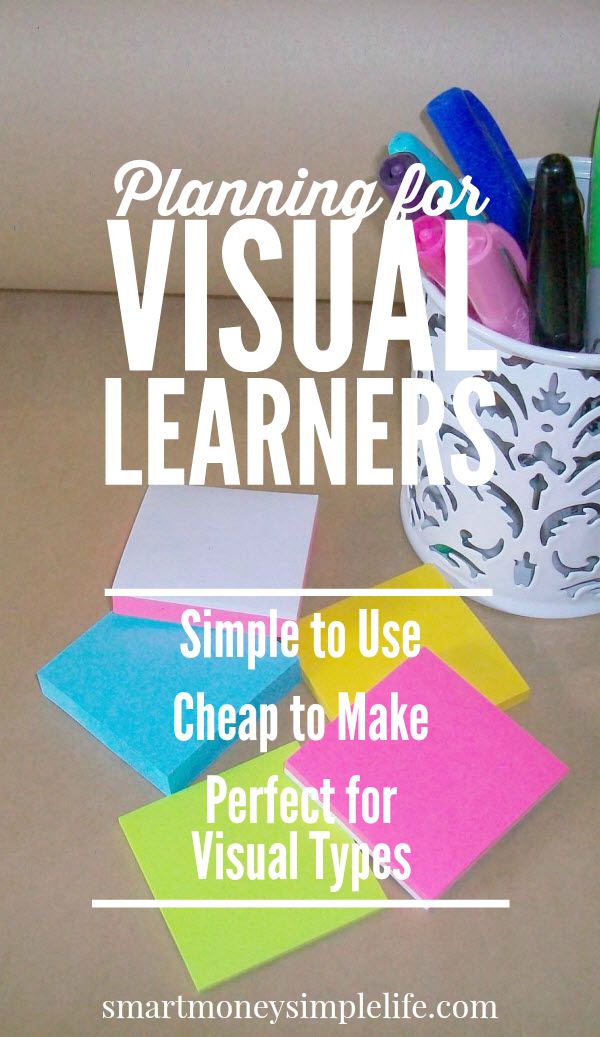Over the years I’ve spent hundreds, perhaps thousands of dollars on planners and diaries. Most of that money was wasted. Why? Because I’m a visual learner.
It doesn’t matter how attractive the diary or planner is on the outside, if you’re a visual learner you’re going to find that diary is probably more useful to you as a door stop than it is as a way to keep track of and generally organize your life.
And, it really doesn’t matter how it’s laid out on the inside either: it can have a section for everything or be completely blank. It doesn’t matter, it still won’t work for you. So, how do you know if you’re a visual learner? Read on…
*** Note: This post contains affiliate links. ***
Table of Contents
Are you a Visual Learner?
One of the key aspects of being a visual learner is this: If you can’t see it all the time, it doesn’t exist.
Here is LearningRx‘s description of a visual learner:
Visual Learners: See
Visual learners learn best by looking at graphics, watching a demonstration, or reading. For them, it’s easy to look at charts and graphs, but they may have difficulty focusing while listening to an explanation.
On some level, I’ve always known this about myself. I get distracted very easily when just listening in either lectures or meetings and a trick I adopted a long time ago was to doodle while listening. It seems counter-intuitive but, it definitely helps me retain more information.
But, back to planners…
I have tried every type of planner you can name, I’ve even tried the Bullet Journal method, which is a brilliant approach to keeping your life and tasks under control. And, I really wanted it to work for me. I was sure this method would suit my love of bullet points and my inability to color inside the lines of a traditional planner. Unfortunately, I just made a mess of a beautiful Moleskine journal.
Then one day, I saw a picture (on Facebook, I think) of someone brainstorming a business plan using a large piece of brown paper and a Sharpie. Bam! An idea was born: a perpetual planner that’s simple to use, cheap to make and perfect for visual learning types.
The Perfect Planner for Visual Learners

The image above is the rough, first version of my visual planner. You can tell it was a test version because I just hacked off a section of paper and drew the divisions free-hand. I’ve been disappointed by planners so many times in the past, I didn’t want to invest too much time and energy into this one until I was sure it was going to work.
Guess what? I’m still using this version.
This system works brilliantly for me. I can see it from my desk. I can move the Post-It notes to the ‘Today’ section when I’m ready to work on them and I can move them back to their respective section if I need to bump them off the day’s schedule for any reason.
Another thing I love is, when I get an idea or find an inspiring quote, I can quickly jot it on a Post-It note and put it on the planner. No more scraps of paper piling up on (and sometimes under) my desk. No more lost ideas.
Related Posts:
- How Do You Want Your Life to Change in 2017?
- Get more done every day; three habits of uncommonly focused people
- Time Management and Why You Should Eat Frogs for Breakfast
- My First Year of Blogging
- What Matters Most? Figure that out and everything else falls into place
- 7 Simple Steps to Make the Most of Every Day
- The Hidden Value of a Good Goof Off Day
- 30 Day Challenge – Try Something New for 30 Days
‘Big Picture’ Planning
I’m not sure if this is a concept most often connected with visual learners but I also like being able to see the big picture. This is another area where a traditional diary just didn’t work for me.
When I look at my planner I can see the direction in which my work is moving as well as the steps to get there.
I color code the Post-It notes based on the type of task it is. This means I can see if I’m running low on post ideas or I’ve nearly finished adding the new listings on my Etsy store so it’s time to begin planning the next housekeeping task.
I know this method of planning has made a big difference to the effectiveness of my work hours. If I find my mind wandering, I glance up at the planner on the wall and I can bring my focus back to the tasks for the day. If you’re a visual type, I’m sure you suffer from the same weakness for visual distractions. Having a visual anchor really helps get you back on task.
My only regret since discovering this method of planning is that I didn’t discover it earlier!
It still amazes me that a chance encounter with an unrelated image sparked what appears to be the most effective time management and planning tool I’ve ever used. Ever!
It also proves you don’t need to spend a lot of money on a planner or diary… you just need to find one that suits your particular learning style. And, I can say from experience, this one works a treat for visual learners like me. If you’re a visual type you might benefit from this style of planner, too.
Your turn…
Do you struggle to make diaries and planners work for you? How have you solved that problem?
Recommended Products


